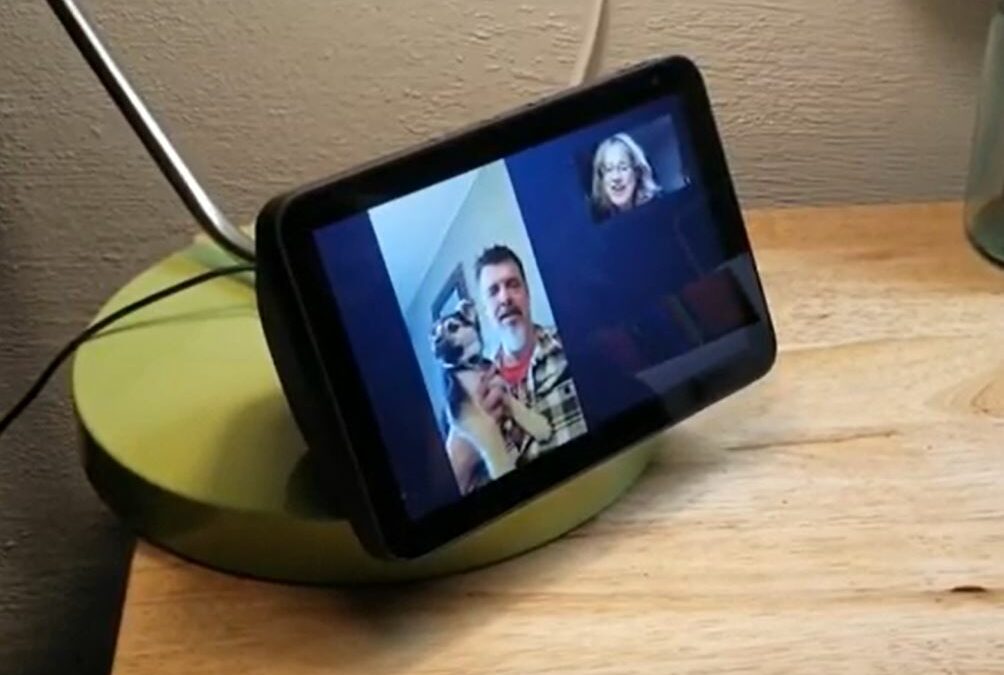With COVID-19, you may have heard stories lately of seniors, people with disabilities, and those with health issues only being able to have “face-to-face” conversations with their loved ones through a window. But what if no one can get to their window, and they are not technically savvy enough to do a video call like Messenger, Facetime, or Zoom? What if they do not have the cognitive or physical skills to dial the phone or push the button to answer? At ND Assistive, we get questions like this all the time, especially now, and there are many great solutions. Today, though, I want to talk about one feature on one device, “Drop-in” calling with the Amazon Echo Show.
Drop-In Feature of the Amazon Echo Show
The Amazon Echo Show, one of the many Alexa voice assistants with a touch-screen display, has many benefits for seniors and for those with disabilities, but the “Drop-In” hands-free video calling is the pièce de résistance, in my opinion. The Drop-In feature for the Echo Show allows a family member to video-call another, simply by saying something like “Alexa drop-in on Grandma”. Grandma only has to be within earshot of her Echo Show to be able to hear the call, which starts automatically. Then she can see and talk to whoever is on the call. She does not have to touch the screen or say anything to accept the call. The family member doing the calling sees the picture of Grandma slowly fade in, which gives Grandma time to prepare herself for the call.
Now, this whole thing may sound intrusive, but it all has to be set up ahead of time and permissions must be granted in the set-up by the users. Hence, no one will be able to do this unless you give them permission. If a person has higher-level cognitive and memory skills, they can just enable the standard video calling feature. This feature will allow a person the choice to accept or ignore calls, as well as, to make them by voice, i.e. “Alexa call Dennis.” Michael Simon from Tech Hive does a wonderful job explaining how to set up calls and which devices can be used to make and receive calls.
Video Demo
This video demonstrates how to answer a Drop-In video call on the Amazon Echo Show by doing absolutely nothing, which is great for seniors who shy away from technology, people with cognitive or physical disabilities, and more. This particular call was initiated from an Amazon Alexa app on the man’s phone with a command: “Drop in on Jeannie”. It was answered automatically because of permissions given beforehand. Calls can be ended on either end by saying a command like “Alexa, hang-up on Dennis” or by pushing the hangup button on the Alexa App.
Drop-in video calls would be great for:
- Loved ones isolated in different parts of a house, nursing home, or the Country;
- People with dementia who no longer understand how to answer or dial a phone;
- People with a physical disability who cannot use a standard phone or tablet for video;
- People who just don’t want to deal with technology but would LOVE a face-to-face video call from the “fam”;
- People with a cognitive or hearing loss who cannot understand you without reading lips, seeing facial gestures, or sign language;
- People with mental health needs who could really use a great “in-person” visit; or
- When you need to SEE the “Just Listen, Linda” kid in your family because a flip phone just won’t cut it!
How to Get the Echo Show to a Loved One, COVID-19 Style
So with this Pandemic, how do you get near your loved one to even set it up? Even though it is a piece of cake for the person receiving the call to use, someone will still have to set it up. Here are some suggestions.
User’s Wi-Fi Network and Password is Known
Well, fortunately, you can set up the Show before you ship it or deliver it as long as you know the Wi-Fi network name and password. Amazon has some good directions.
If you do not know the Wi-Fi information
- If there is someone at the person’s home that can follow-step by step instructions to set it up, you can walk them through on the phone or provide them with an instruction sheet.
- Another way would be to go to their home, to the outside only, of course, and somehow plug it into an external power source within Wif-Fi range, like the garage, and finish the setup.
User Has No Wif-Fi
I recently learned the following from Eliza Anderson, AT3, and Therese Willkomm, the New Hampshire AT Program. If you have a tech-phobic loved one who doesn’t have the internet, one solution is taking an old smartphone and using it to create an internet hotspot (if they’re not in a cell service dead zone). You can add a line to your cell plan, and plug the phone in somewhere unobtrusive in the home for continuous power. Activate the “personal hotspot” option in settings and connect the Echo Show. I thought this was a great idea. I tried it with my Echo Show, and it works very well.
Ways to Obtain the Echo Show
The Echo Show is available from Amazon and other retailers in 3 different sizes (5″, 8″, and 10″). The 10″ screen would be a nice size for someone with low vision. If funding is difficult, we have several programs that might help including our Specialized Phone Program for those North Dakotans who qualify. If you just want to try it, we do have a few in our short-term equipment trial program. You can also request a virtual demonstration over video. Please reach us at info@ndassistive.org or 1-800-895-4728.


